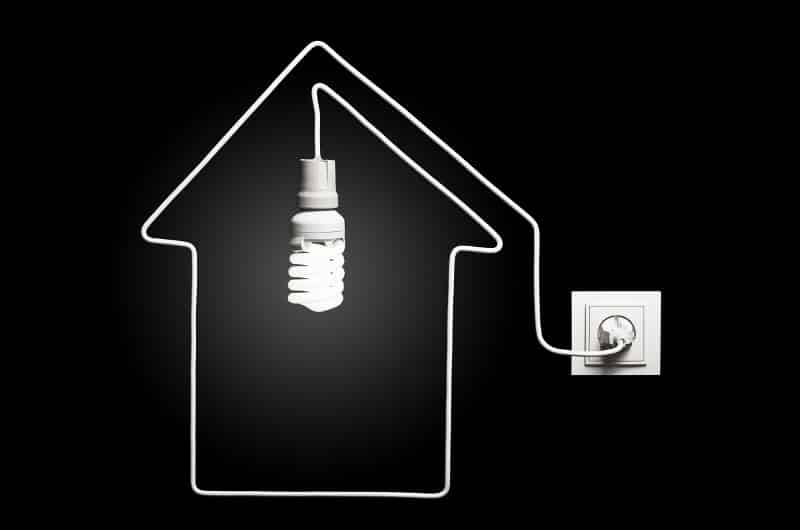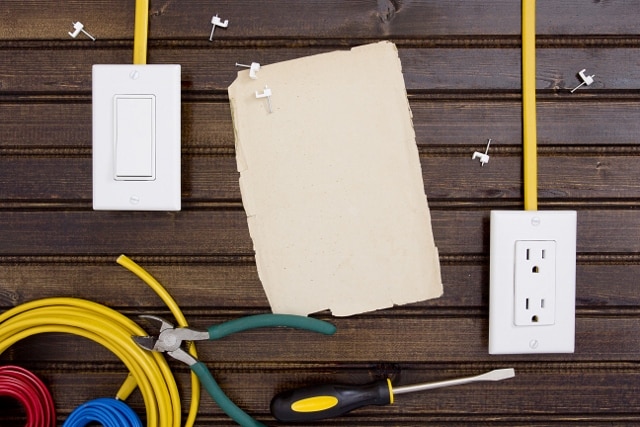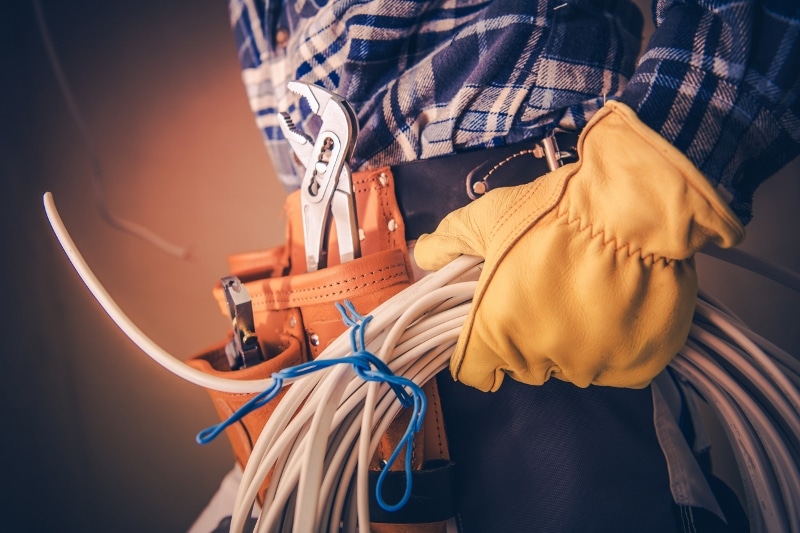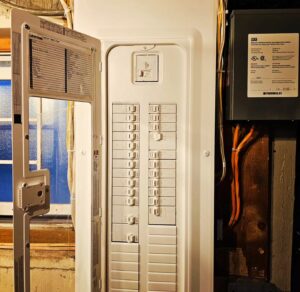
When you think of a surge protector, you likely think of a power bar. Surge protectors are commonly used when putting together a computer system. When you plug in multiple electronics into one power bar and then plug that into one outlet, a built-in surge protector can protect your electronics from surges in the electrical system.
You can also purchase surge protectors that allow just one item to be plugged into them. These are called point-of-use surge protectors. Bring this idea to a much larger scale and consider a surge protector that can protect the entire house from these surges. How do they work? Are they truly effective? How much do they cost? This article explains.
Table of Contents
ToggleWhat are surges?
Before going into how a surge protector works, it is important to know what surges are. A power surge in your electrical system can also be referred to as transient voltage. Basically, it’s a significant and often sudden increase in voltage that is above and beyond what your circuit was designed to handle.
Let’s say an electrical system has a standard voltage of 120 volts. If that voltage suddenly spikes above 120 volts, it can destroy or damage any electronics plugged into it. Think of it like a water hose that has too much water pressure. Eventually, it will burst. Your electrical system will react in a similar manner. Even if it doesn’t break your electronic, it will cause premature wear and tear on them.
What causes electrical surges?
A surge will happen when something elevates the electrical charge somewhere along the main power line. This boosts electrical potential energy, which increases the overall flow of power into your system and then into the outlets on your wall.
What can cause such a boost in power? Lighting can, for example, although that is rare. The most common cause of electrical surges is high-power electrical devices that are on the line. These would include refrigerators, air conditioning units, and even elevators. These appliances need a lot of power just to turn on and off. If you’re in a multi-unit building and you share an electrical system with one of these appliances, power surges can occur.
However, smaller electronics can cause power surges in your home too and are the most likely culprits. Starting up a hair drier or even a power tool can start one. Internal power surges are the most common and anygiven home can have hundreds occur in a week.
Bad electrical work and faulty wiring, issues with the electrical companies wiring and power lines that have come down are also culprits for electrical surges. The electrical system that exists outside of your home is very complex and there are lots of things that could go wrong. Unfortunately, power surges are events that just happen. The best we can do is be prepared for it.

What is a whole house surge protector?
A whole-house surge protector can help protect the appliances and electronics in your home from those frequent and unpredictable voltage boosts. They do so by blocking or grounding the high voltage flow and limiting the current that flows through your house. Think of it as a pressure relief valve. Since most of the surges will be internal surges caused by something in your house, like your dishwasher cycling, having one of these is certainly worth the investment.
Start adding up the value of your electronics. Once you calculate the cost of replacing computers, theatre systems, televisions, game consoles, and appliances, you’ll probably be well over $15,000 for everything plugged into your electrical system. For many homeowners, that is worth protecting.
Power surges are an inevitable and regular occurrence. You want to protect the things plugged into the electrical system. A whole-house surge protector can help you do that.
How does a whole house surge protector work?
To block and/or limit the electrical flow, a surge protector uses Metal Oxide Varistors (MOV). These components work like magnets for the extra voltage. They suck it in and essentially send it down the ground wire before it can blast through your circuit and damage your electronics and appliances.
This is how a power strip surge protector works. Unfortunately, there are devices and appliances in your home that cannot be plugged into a power strip. These items are also your home’s most expensive things. They include your lighting, air conditioner, oven, refrigeration, washer and dryer, dishwasher and other major appliances.
Are there devices that are more susceptible to power surges?
Most components in today’s electronics can be damaged by electrical surges. Electronics that contain microprocessors are even more sensitive to surges. Microprocessors only work correctly when they have a specific voltage. They’re fragile, so any increase in power can cause damage. Microprocessors are in most of today’s technology, including kitchen appliances and your entertainment system.
How effective are whole house surge protectors?
Whole house surge protectors work when it comes to saving your home from dangerous surges. However, they do not stop all surges. They are designed to keep the flow of electricity within a certain range. That means they let through surges that are below the designed range. Just because the surges are smaller, doesn’t mean they are not dangerous. That means super sensitive electronics should still use a power strip, or another point-of-use surge protector to guarantee protection.
Some whole home surge protectors will only protect your home when the voltage reaches dangerous, fire-causing levels. At these levels, appliances and electronics would be destroyed and it could even cause an electrical fire. Lower voltage surges can still damage some appliances.
For example, a whole house surge protector might cap out at a volt protection rating (VPR) of 700 volts. A point-of-use surge protector that you plug into your outlet can block surges between 127 volts and 400 volts. 120-volt electronics can fry with even a small surge.
When in doubt, use both.
Unfortunately, these power strip or plug-in surge protectors cannot handle the massive surges that a whole house protector can. Some point-of-use surge protectors can overheat and even catch on fire if a surge comes through that is higher than their VPR. That is why the best defense is to have both. A whole-house surge protector to block the large voltage boosts and a few point-of-use protectors for your expensive and sensitive electronics.
You can also buy a whole house surge protector that has a lower VPR. The lower the voltage protection rating, the smaller the gate is for electricity to enter your home. You don’t need more electricity than is required to safely run your appliances. So, ask your electrician about a whole house surge protector with a lower VPR.

How much does a whole house surge protector cost?
The device itself can range in cost from $100 to $400 dollars depending on the brand, complexity and VPR rating. For the surge protector, plus installation from a licensed electrician, you can expect to pay between $300 and $750.
There is a range because there are some factors that determine the cost. These factors include the specific surge protector you buy, the warranty it comes with, whether you have a subpanel or not and the contractor you hire.
Subpanel
If you have a subpanel, you might need more than one surge protector to protect the entire house. Double the product and double the installation costs. You would have a subpanel if you run any circuits far from the main panel like a workshop or garden suite. If you had an electrical upgrade to add more circuits to the electrical system, you would have a subpanel. If you’re not sure, ask an electrician.
Surge protector
Just like any product, the brand you choose makes a difference in price. The lower the voltage protective rating, the higher the unit will cost. This is because it can essentially block out more high voltage surges. If it has a higher Maximum Continuous Operating Voltage, it will raise the price. Also, the higher the Maximum Surge Current Capacity, the higher the cost.
Warranty
Again, just like anything you buy, the more extensive the warranty the more expensive the surge protector installation will be. Check the fine print. Sometimes a warranty won’t cover damages under certain conditions. For example, they won’t cover damage if a certified electrician didn’t do the install.
Electrician
Every electrical company has their own fee system. Usually, the more experience the electrician, the more you’ll likely pay for installation. That said, you get what you pay for. It’s worth it to hire a licensed, insured and experienced electrician to do any electrical work in your home. Your home’s electrical system can be a potential danger. A small mistake can cause a lot of damage.
How to install a whole house surge protector:
Choose a surge protector.
You must purchase the correct surge protector model for your home. This guide shares useful information to help you select and size the right surge protector for your electrical system.
Turn off the electricity.
Locate your main panel and flip the main breaker switch to cut all power to your house. An energized panel can be dangerous, using a voltage detector to make sure it’s no longer getting any electricity is best. Touch the tip of the detector to the main power wires. If it lights up, that means your panel is still getting power.
Find an empty knockout.
Knockouts are quarter-sized openings on the side of electrical boxes. They allow you to service the box by running wires in and out of it. There should be one along the side of the metal panel. This will be where the surge protector gets mounted.
Attach the surge protector.
Now that there is an opening, wires can be fed through it. Loop the wires out the front of the panel so they’re out of the way. Every surge protector is different. Some might have screws to tighten at the bottom or a threaded mount that sets into the panel. Read the manufacturer’s instructions for mounting that came with your surge protector.
The surge protector can be mounted inside or outside the panel, but it’s recommended to mounted it outside. Then you can check it without opening the panel.
Connect the wires.
Here’s where it can get tricky. There are four wires. White is neutral, green the ground wire and the two black wires complete the circuit. Remove some insulation from the wires to expose the conductor. Be extra careful to use the right gauge of wire strippers when doing this. If you scar the cable you can diminish the effectiveness of the surge protector.
Feed the wires through the holes in the large metal strips on the side of your breaker panel. Tighten the screw to hold them in place. Green goes to the ground bus bar and neutral goes with the other white wires. The black wires are connected to a dipole breaker. Feed them into the port throught the side and tightening the screw. Again, if you are unsure, please hire a certified electrician to do this for you.
Put the panel back together.
Put the panel cover in place and reinstall the screws that hold it in place. Be careful when doing this. You can accidentally flip a breaker in the process. Once the panel is tight and there are no gaps, turn the main breaker back on.
Test it.
Flip the dual break and you should see little lights on your surge protector indicating that it’s connected to power. If there are no lights, turn the power back off and inspect the dipole breaker again. If it still doesn’t work, contact a professional electrician.

Installed by an electrician or DIY?
A system-wide surge protector should be hard-wired to your electrical box by a professional electrician. Installing it properly is vital. It must be grounded correctly, or it won’t be able to do its job. You should always leave electrical installations to a certified electrician. Any mistakes could cause personal injury or a future fire hazard. This is not something you want to DIY.
For an experienced electrician, installing the surge protector should take a couple of hours. To someone who isn’t skilled and experienced in electrical, it could be a complicated task. There is a lot of wiring coming in and out of your service panel. For the safety of your home, family and everything plugged into the wall, connect with a professional electrician to install your whole house surge protector.
You should also consider the warranty for your whole house surge protector. As mentioned above, the warranty probably won’t cover damages to any electronics caused be a surge if it was a DIY installation. If a surge causes a fire, your home insurance policy might not cover damages if any electrical upgrades were not done by a certified electrician. Don’t take chances. Hire a reputable, experienced and trained electrician for this job and any other electrical jobs.
Find a RenovationFind Certified electrician in your city!









